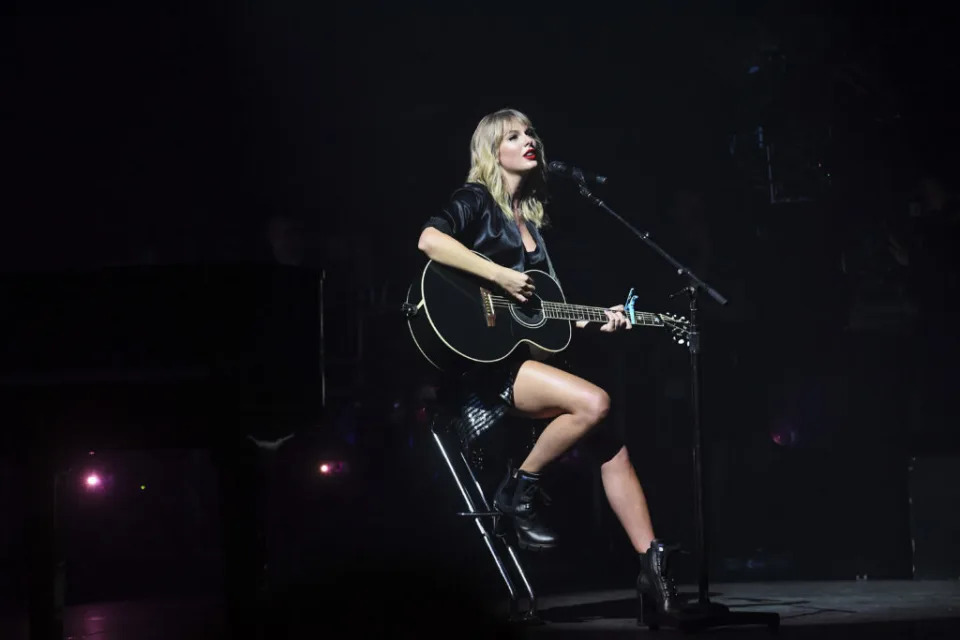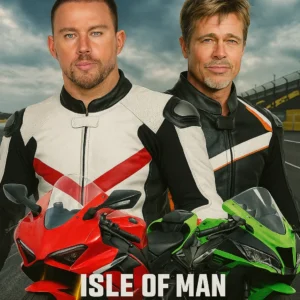Taylor Swift’s 10th album, Midnights, recently became the first album in seven years to sell a million in a week, setting a variety of Billboard records including occupying the entire top 10 of the Hot 100. But at this point, it almost feels like record-breaking success is routine for the Pennsylvania-born Swift, one of the most popular American singers of the last 20 years. Since debuting as an earnest teenage country prodigy in 2006, Swift has rebooted and reinvented her sound several times — from the nostalgic synth-pop of 1989 to the scaled-down indie pop intimacy of Folklore, topping the charts all the while.
Swift will hit the road in 2023 for The Eras Tour, celebrating her entire career, including the four new albums she’s released since her last tour five years ago. And since 2021, Swift has been engaged in the unusual practice of re-recording all of her early albums in response to not being able to own the masters, with Fearless (Taylor’s Version) and Red (Taylor’s Version) both topping the charts last year. But out of Swift’s original albums, what’s her best? And where does Midnights fit in the big picture of her catalog?
(Credit: Dave Hogan/ABA/Getty Images)
10. Lover (2019)
It was a given that Taylor Swift’s follow-up to Reputation would probably be a little lighter. But Lover’s lead single, “ME!” with Brendon Urie of Panic! At The Disco, was a garish overcorrection and a strained ode to positive thinking. The air of forced joviality continues throughout Lover, especially with Swift’s theatrical fake laugh in the opener “I Forgot That You Existed.” And the cornball “London Boy” is definitely in the running for the worst track Swift has ever placed on an album.
That’s not to say that there aren’t some great songs swimming in Lover’s ungainly 18 tracks that hint at the blockbuster pop smarts of 1989. “The Man,” co-produced with New Zealand hitmaker Joel Little (Lorde’s “Royals”), is an airtight synth-pop anthem with a clever chorus that allows Swift to flex her accomplishments and cast a withering eye at sexist double standards in one fell swoop. And “Paper Rings” is a feisty Jack Antonoff-assisted indie-pop stomper. “Lover runs long, and despite a strong front half the album sags a bit in the midsection by design – a shame, since a sense of experimentation ebbs and flows throughout,” Larry Fitzmaurice wrote in the Entertainment Weekly review.
9. Taylor Swift (2006)
The 16-year-old Taylor Swift that the world met on her debut album was already the full package, a smart and perceptive writer with a voice you’d be able to recognize after hearing it once. There were just a lot more pickup trucks and screen doors in her lyrics back then, and a little more Natalie Maines in her delivery. “Tim McGraw” made her country famous, “Teardrops on My Guitar” started the long process of her pop crossover, and the album crossed the 3 million mark before the follow-up was released. “Swift looks at life with a simplicity I abandoned a long time ago, but the songs have a musical maturity that prevents them from becoming country bubblegum music,” Janis Fontaine wrote in The Palm Beach Post.
8. Reputation (2017)
After 1989, Taylor Swift had cemented her status as the reigning queen of pop, pulling decisively ahead of every competitor. But the crescendo of Swift’s long public drama with Kanye West left her feeling embattled enough to make a dark, swaggering, clubby album that’s exhaustingly defensive about her newfound role as a pop culture villain. Amid all of the bombastic bangers and ill-advised posse cut with Future and Ed Sheeran, “Delicate” stands out as a sweet, vulnerable moment that takes the synth-heavy aesthetic of Reputation in a different direction, laying the foundation for a more intimate album like Midnights. “Her interest in hip-hop and R&B is most apparent in her voice, an instrument that’s been stripped of its signature expressiveness. Her best performances throughout Reputation are defined by cadence and rhythm, not melody: she’s cool, conversational, detached,” Jamieson Cox wrote in the Pitchfork review.
7. Evermore (2020)
Taylor Swift has never made the same album twice, but she came the closest when she followed Folklore six months later with its sister album, Evermore. Aaron Dressner does throw some curveballs at Swift, however, like the 5/4 time signatures on “Tolerate It” and “Closure.” And HAIM collaboration “No Body, No Crime” is one the more novel moments on either album, a snarky Taylor Swift spin on a country murder ballad. “Although Folklore’s moody, ‘indie’-inspired sound is still the dominant feature of Evermore, there’s room for more variety and experimentation this time around,” wrote Claire Shaffer in the Rolling Stone review.
6. Midnights (2022)
Like Speak Now, Midnights is a concept album that acts as a clearinghouse for over a dozen episodes from Taylor Swift’s life that were ready to become a song. And because each of these stories takes place in the dead of night, Swift and Jack Antonoff have constructed a nocturnal aesthetic for Midnights, full of bass-heavy midtempo beats and heavily reverbed synths. It’s almost like Swift created a whole album out of the parts of Reputation that worked. The songs are bathed in such a hazy Lana Del Rey atmosphere that you almost don’t notice when Del Rey herself shows up on “Snow on the Beach.”
The pitched-down vocals on “Midnight Rain” and “Labyrinth” feel like an embarrassing relic of 2010s Soundcloud production trends. But “You’re On Your Own, Kid” and the sparkling “Karma” exploit the full potential of this sonic playground, and “Mastermind” and “Anti-Hero” sizzle with clever, self-deprecating humor. “While Midnights, Swift’s shortest LP at 44 minutes, is no masterpiece – and she’d do well to invite fresh collaborators for the next project – never has the star written so unabashedly about the woman in the mirror,” was Bobby Olivier’s assessment in the SPIN review.
5. Speak Now (2010)
For 50 years, people have obsessed over whether Carly Simon’s 1972 hit “You’re So Vain” was written about Warren Beatty, Mick Jagger, or some other famous man. But Taylor Swift became the master of blind item pop on her third release, a concept album in which each song is addressed to an unnamed recipient. Alleged subjects of the songs on Speak Now include famous exes John Mayer and Taylor Lautner, awards show instigator Kanye West and even crabby music industry commentator Bob Lefsetz.
In between the early hits co-written with Liz Rose and her ultra-collaborative pop era, Speak Now is the only album on which Swift is the sole songwriter. And with its subtle variety of perspectives and aesthetics, it’s a strong showcase for what she can do on her own. “Swift lays claim to several genres’ worth of signatures, from the lush strings of Celine-style kitsch pop to Americana banjo to countrypolitan electric guitar. She surveys this wide ground without bluster; she never poses,” Ann Powers wrote in the Los Angeles Times review.
4. Folklore (2020)
For seven straight albums, everything Taylor Swift did was louder, brighter, and more polished than its predecessors. But after heading in the same direction for over a decade, the COVID-19 pandemic gave Swift an opportunity to step back and scale down. Unable to tour in support of Lover, she stayed home and made an uncharacteristically quiet album. Instead of a “back to basics” return to country, however, Folklore was a pivot towards the kind of “indie record much cooler than mine” that she’d sniffed about on one of her pop hits — complete with members of The National and Bon Iver assisting. Even without radio hits, the album was a massive success. It won the Grammy for Album of the Year, making Swift one of the few to win the award three times, alongside Frank Sinatra, Stevie Wonder, and Paul Simon.
The Folklore opener “The 1” is one of the most arresting and evocative songs about the exhilaration and disappointment of a brief relationship that Swift has ever written (and she has a few). “The Last Great American Dynasty” shows her flexing her imagination, building an entire narrative around the house the album was recorded in. “Swift’s longest lyrical obsession is the loss of innocence, a theme she makes fairly devastating here,” Laura Snapes wrote in a review for The Guardian.
3. Red (2012)
Red was the transition point where Taylor Swift finally admitted to herself (and everyone else) that she wasn’t going to stay in the country music world forever. There are still a few Nashville-friendly tracks produced by Nathan Chapman and Dann Huff, and pleasant pop/rock with Semisonic’s Dan Wilson and Snow Patrol’s Gary Lightbody. But Red is at its best when it swings big and risks failure, as with Max Martin and Shellback throwing dubstep drops into “I Knew You Were Trouble.” “The Martin collaborations are the ones that will cause the most turbulence for her old country fans, but Swift throws plenty of curveballs to make the rest of the albums – like the arena-rock guitars that launch opening cut ‘State of Grace’ and the five minute-plus slow build of ‘All Too Well’ – an occasionally fascinating work,” Michael Gallucci wrote in the AV Club review.
2. 1989 (2014)
Taylor Swift named her fifth album after the year of her birth, but it doubles as a tribute to an era of pop that was dominated by the big, shiny blockbusters of MTV’s heyday. And 1989 became a hit factory in the tradition of Like a Prayer or Full Moon Fever, spinning off inescapable singles like “Shake It Off,” “Blank Space,” and “Bad Blood.” But even deep cuts like “I Wish You Would” and “How You Get The Girl” sound like a million bucks as Swift pulled together her dream team of Top 40 hitmakers like a returning Max Martin and Greg Kurstin. The dippy opening track “Welcome to New York” may be the album’s only glaring misstep. “1989 is Taylor Swift’s radical reinvention: one to finally alienate her country audience and plant her flag firmly in pop soil,” Matthew Horton wrote in the NME review.
1. Fearless (2008)
Taylor Swift’s debut was a very big deal by any standard, but it almost feels like small potatoes next to her sophomore album. Buoyed by the crossover success of “Love Story” and “You Belong With Me,” Fearless eventually went 10 times platinum, joining a few sets by Garth Brooks and Shania Twain as the rare diamond-selling country album. And the album remains a masterpiece of high school anxiety and adolescent heartbreak with “Fearless” and “Tell Me Why” still standing among the best songs Swift has ever written. “All over her fantastic second album, the country phenom gets bedeviled by the boyfolk, making the thrills and spills of a two-week teen romance sound as torchy as one of Patsy Cline’s marriages,” Rob Sheffield wrote in the Blender review.




